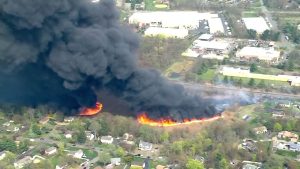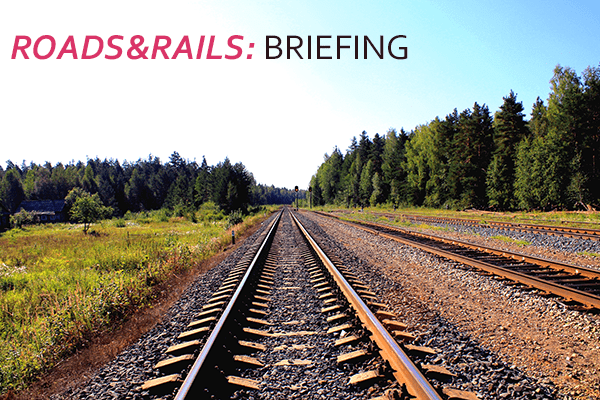|
RCBJ-Audible (Listen For Free)
|
No Surprises, But Rockland County Sheriff Office Say CSX Rail Fires Caused By Carbon Emission From Exhaust Stacks
Rockland County Sheriff’s Office investigators say the cause of a chain of brush fires along the CSX railroad tracks on April 14 was caused by carbon emissions from the exhaust stacks, which can “undergo glowing combustion for more than a minute, with flaming combustion for more than 40 seconds.”
The Sheriff’s office has just released its report.
Nearly two dozen fires broke out along the tracks from Congers to Stony Point within minutes of each other that afternoon. Soot and embers alit in yards near the railroad tracks, black smoke billowed visibly for miles, and Highway 304 was closed for several hours. A handful of homes were damaged. Three firefighters were treated for heat exhaustion as temperatures hovered near 90 degrees.
 Representatives from CSX arrived the afternoon of the fire and went door to door passing out forms for residents to apply for reimbursement of damages. A week later, the Sheriff’s Office opened an investigation.
Representatives from CSX arrived the afternoon of the fire and went door to door passing out forms for residents to apply for reimbursement of damages. A week later, the Sheriff’s Office opened an investigation.
While the Sheriff’s Office completed its investigation, businesses and municipalities affected by the fires have already been receiving compensation from the company.
“To date, we have helped secure close to $100,000 from CSX for residents who have contacted my staff,” said state Sen. Bill Weber. “The resolution process is ongoing, and we anticipate a total payout of nearly one million dollars. This financial relief will be crucial in restoring affected communities and mitigating the damages caused by CSX’s negligence.”
The fires started appearing at 1:47 p.m. in Stony Point as the train increased speed to full throttle. Multiple independent origin fires began appearing from north to south on the wind-protected west side of the tracks as the train went through West Haverstraw and Haverstraw and into Congers.
Most of the fires were within 40 feet of the tracks on the west side. The exception: the entrance and exit of the tunnel between Haverstraw and Congers, where the track is protected from winds off the Hudson River — and there, brush ignited on both sides.
Fires ceased after CSX was notified and reduced the train’s speed.
It remains a theory, but investigation of the tracks, examination of the axles, wheels, brakes and undercarriages of the train cars, and multiple video from security cameras and train cameras show “no other possible contributing factor other than the CSX train,” the report said.
With Amtrak Suspending Montreal Service, Trailways Revs Up
With Amtrak passenger trains having suspended service to Montreal, Canada, due to problems with the tracks north of the U.S. border, the Trailways of New York bus company is increasing its daily trips there. The bus service is now offering four new trips, bringing to 10 the number of journeys each day between New York City and Montreal, with stops along the way.
In addition to New York City and Albany, the additional trips will also stop in Plattsburgh, Glens Falls, Saratoga Springs, Catskill, New Paltz, and Ridgewood, N.J.
 In Albany there are three stops: Albany International Airport, downtown Albany and UAlbany.
In Albany there are three stops: Albany International Airport, downtown Albany and UAlbany.
Trailways buses are equipped with Wi-Fi, power outlets, restrooms and seating for those with disabilities.
Amtrak suspended service to Montreal late last month amid fears that the steel tracks in Canada could warp in temperatures that were exceeding 86 degrees.
The suspension grew more complex this week when, according to the Montreal Gazette newspaper, Canadian officials said that Amtrak hasn’t been paying its fair share for maintenance, a charge that Amtrak disputes. Officials with the Canadian National Railway, which owns the Canadian tracks, said that had there been more money from Amtrak, there would have been more funding for track maintenance.
Amtrak had restarted its New York City to Montreal route in April, following a three-year hiatus due to COVID-19.
Gateway Tunnel Project Beneath Hudson To Get $6.9 Billion Federal Grant
Funding the $16.1 billion Gateway project to build a new tunnel that would carry rail lines beneath the Hudson River from New Jersey into Manhattan has moved forward with a $6.88 billion federal grant.
 The new tunnel is needed, project backers say, because the existing tunnels that carry two rail lines beneath the Hudson — which date to 1910 — were drastically compromised by Superstorm Sandy and must be repaired. Once the new tunnel is finished, the old tunnels can be shut one at a time for vital restoration.
The new tunnel is needed, project backers say, because the existing tunnels that carry two rail lines beneath the Hudson — which date to 1910 — were drastically compromised by Superstorm Sandy and must be repaired. Once the new tunnel is finished, the old tunnels can be shut one at a time for vital restoration.
Chuck Schumer, who represents New York, has fought to get this project moving for more than a decade since then-Gov. Chris Christie put the kibosh on the previous ARC tunnel project in 2010, and later when former President Donald Trump slowed progress.
“We have to do this quickly because these are hundred-year-old tunnels,” said Schumer, who calls this project the most important infrastructure project in the country. “That’s why we’re rushing to get the money now, so we get it under a friendly administration.”
With the project entering the engineering phase, after Federal Transit Administration approval, the Gateway Development Commission will have access to much of the new grant money to advance the project. An official grant agreement between the GDC — the bistate agency leading the project design and oversight — and the FTA is not expected to be finalized until next year.















